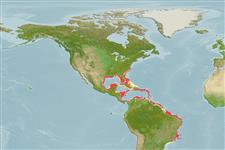Klassifizierung / Names
Namen | Synonyme | Catalog of Fishes(Gattung, Arten) | ITIS | CoL | WoRMS | Cloffa
>
Eupercaria/misc (Various families in series Eupercaria) >
Labridae (Wrasses) > Corinae
Etymology: Halichoeres: Greek, als, alis = salt + Greek, choiros = pig (Ref. 45335).
More on author: Agassiz.
Environment: milieu / climate zone / Tiefenbereich / distribution range
Ökologie
seewasser riff-verbunden; tiefenbereich 3 - 60 m (Ref. 52607). Tropical
Southwest Atlantic: French Guiana to the State of São Paulo, Bazil.
Size / Gewicht / Alter
Geschlechtsreife: Lm ? range ? - ? cm
Max length : 27.0 cm SL Männchen/unbestimmt; (Ref. 114982)
Rückenflossenstacheln (insgesamt) : 9; Rückenflossenweichstrahlen (insgesamt) : 12; Afterflossenstacheln: 3; Afterflossenweichstrahlen: 12. Juveniles and females blue with a bright yellow region dorsally from mouth to posterior base of dorsal fin; caudal fin with a single dark spot. Adults with a broad blue stripe on upper half of body ending at the beginning of the caudal fin; lower half of body light blue; a diagonal dark band from eye to nape. Two pairs of enlarged canine teeth anteriorly in the lower jaw (Ref. 52607).
Body shape (shape guide): fusiform / normal.
Usually observed solitary; juveniles relatively common in shallow waters (3 - 20 meters) while adults are in deeper waters (30 - 60 meters) (Ref. 52607).
Life cycle and mating behavior
Geschlechtsreife | Fortpflanzung | Ablaichen | Eier | Fecundity | Larven
Distinct pairing during breeding (Ref. 205).
Rocha, L.A., 2004. Mitochondrial DNA and color pattern variation in three Western Atlantic Halichoeres (Labridae), with the revalidation of two species. Copeia 2004(4):770-782. (Ref. 52607)
IUCN Rote Liste Status (Ref. 130435: Version 2025-1)
Bedrohung für Menschen
Harmless
Nutzung durch Menschen
Tools
Zusatzinformationen
Download XML
Internet Quellen
Estimates based on models
Preferred temperature (Ref.
123201): 24.7 - 28, mean 27 °C (based on 314 cells).
Phylogenetic diversity index (Ref.
82804): PD
50 = 0.5000 [Uniqueness, from 0.5 = low to 2.0 = high].
Bayesian length-weight: a=0.01148 (0.00671 - 0.01964), b=3.13 (2.98 - 3.28), in cm total length, based on LWR estimates for this species & Genus-body shape (Ref.
93245).
Trophic level (Ref.
69278): 3.6 ±0.5 se; based on size and trophs of closest relatives
Widerstandsfähigkeit (Ref.
120179): mittel, Verdopplung der Population dauert 1,4 - 4,4 Jahre. (Preliminary K or Fecundity.).
Fishing Vulnerability (Ref.
59153): Low vulnerability (23 of 100).
🛈
Nutrients (Ref.
124155): Calcium = 54.3 [33.2, 86.0] mg/100g; Iron = 0.592 [0.353, 1.063] mg/100g; Protein = 18.4 [15.6, 20.6] %; Omega3 = 0.148 [0.101, 0.219] g/100g; Selenium = 29.6 [18.6, 49.9] μg/100g; VitaminA = 123 [38, 434] μg/100g; Zinc = 1.46 [1.05, 2.27] mg/100g (wet weight);
